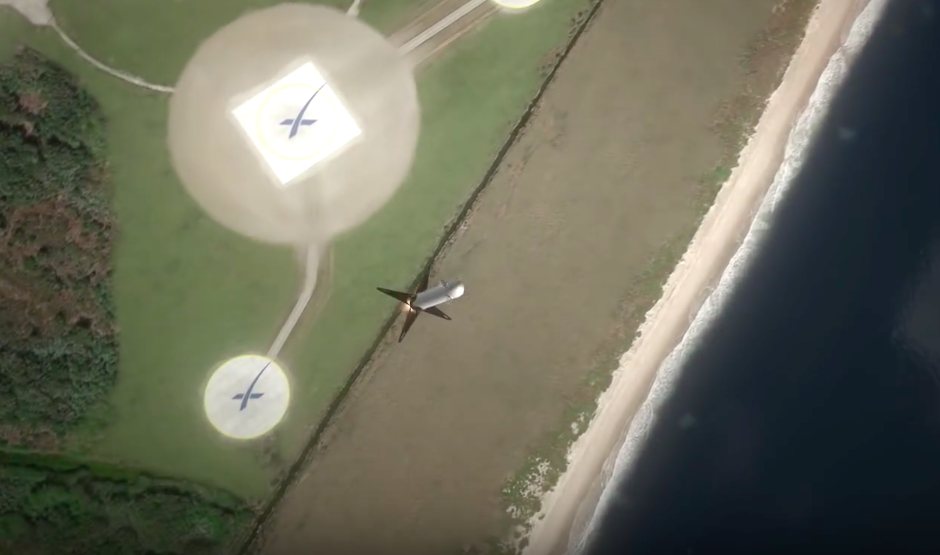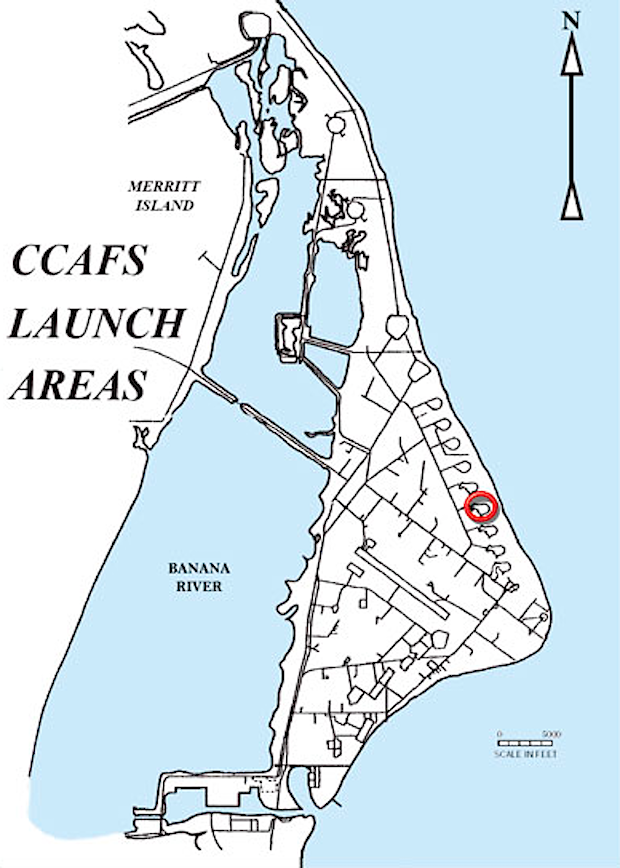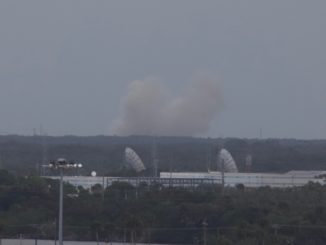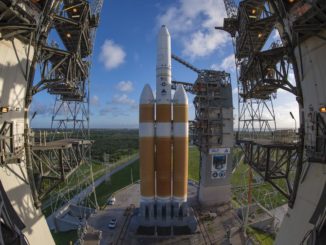
Assuming SpaceX’s plans come to fruition, a Falcon 9 flight from Cape Canaveral on Sunday will end with a vertical rocket-assisted landing at an abandoned Cold War-era launch facility a few miles away.
SpaceX confirmed the rocket’s first stage, a slender cylindrical kerosene-fed rocket body standing 156 feet tall, will aim for a controlled touchdown at a landing pad the company rented from the U.S. Air Force less than six miles south of the Falcon 9’s Complex 40 launch pad.
Liftoff is set for a 60-second window opening at 8:29 p.m. EST Sunday (0129 GMT Monday). A backup launch opportunity is available Monday.
A statement released by SpaceX on Saturday said the company planned to recover the Falcon 9’s first stage booster at Landing Zone 1, previously known as Space Launch Complex 13, an Atlas launch facility that was last used in 1978.
The Federal Aviation Administration was expected to formally approve the landing attempt in SpaceX’s commercial launch license.
The Falcon 9’s second stage engine will continue driving into orbit with 11 Orbcomm message relay satellites, the primary objective of Sunday’s launch, after the first stage unlatches and falls away from the upper stage about three minutes after liftoff.
The first stage will flip around with pulses from cold gas thrusters, then re-ignite a subset of its nine Merlin main engines to propel itself back toward Cape Canaveral from the northeast.

On final descent, the rocket’s center engine will fire up for a landing burn as four legs extend from the base of the booster. Maneuverable grid fins attached to the top of the first stage will help ensure aerodynamic stability.
Touchdown at Landing Zone 1, which sits just north of the eastern tip of Cape Canaveral on Air Force property, is expected within 20 minutes of launch, but the exact time has not been disclosed.
SpaceX has tried to land Falcon 9 boosters on an ocean-going barge in the Atlantic Ocean after two launches earlier this year, but the rockets tipped over after touchdown on the ship. The flight profile to steer the rocket back toward the coast — essentially reversing its course more than 60 miles up in space — has never been tried before, but the final landing sequence should be similar to the descents over the ocean.
The landing will be at night at Cape Canaveral, but the flash of the final descent burn could be visible to spectators.
A video of a landing attempt on SpaceX’s autonomous spaceport drone ship after an April launch showed the rocket’s fall toward the landing target, slowed down by the single-engine descent burn, then cold gas thrusters firing in an effort to keep the rocket upright.
SpaceX officials said a sonic boom could also accompany the landing as the rocket slows from supersonic speed.
“Just as when the space shuttle returned from space, there is a possibility that residents of northern and central Brevard County, Fla. may hear a sonic boom during landing,” SpaceX said in a statement. “A sonic boom is the thunder-like noise a person on the ground hears when an aircraft or other type of aerospace vehicle flies overhead faster than the speed of sound.
“Residents of the communities of Cape Canaveral, Cocoa, Cocoa Beach, Courtenay, Merritt Island, Mims, Port Canaveral, Port St. John, Rockledge, Scottsmoor, Sharpes, and Titusville in Brevard County, Fla. are mostly likely to hear a sonic boom, although what residents experience will depend on weather conditions and other factors,” the statement said.
The Air Force’s 45th Space Wing, the unit which runs the Cape Canaveral spaceport, plans to evacuate much of the base for the historic landing attempt, the first of its kind on Florida’s Space Coast.
If the rocket lands intact, SpaceX engineers will inspect the booster, scrutinizing it to learn how the vehicle weathered the re-entry and how much refurbishment is needed before flying again.
Sunday’s launch also marks the first flight of an upgraded version of the Falcon 9, carrying condensed, super-cold propellants, larger fuel tanks and uprated engines to carry heavier payloads into orbit. The extra performance, coupled with the relatively light weight of the Orbcomm satellites — each one is about the size of a refrigerator — leaves ample propellant for the return to Cape Canaveral.
“If successful, this test would mark the first time in history an orbital rocket has successfully achieved a land landing,” SpaceX said in a press release.
Elon Musk, SpaceX’s chief executive, tweeted about the landing early Saturday.
Currently looking good for a Sunday night (~8pm local) attempted orbital launch and rocket landing at Cape Canaveral
— Elon Musk (@elonmusk) December 19, 2015
Blue Origin, another entrepreneurial space company founded by Amazon.com’s billionaire founder Jeff Bezos, achieved a successful vertical takeoff and landing of its New Shepard booster in Texas in November. While the Falcon 9 rocket is built for orbital launches, the New Shepard is suborbital, traveling just beyond the internationally-recognized 62-mile (100-kilometer) boundary of space.
While the New Shepard is a smaller-scale rocket than the Falcon 9, a point Musk made in a series of tweets after the Blue Origin landing, the suborbital launcher became the first commercial vehicle to take off under its own power, reach space and return to safe landing on the ground.
Email the author.
Follow Stephen Clark on Twitter: @StephenClark1.



